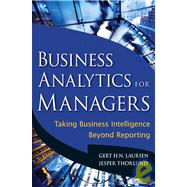
GERT H.N. LAURSEN is head of customer intelligence at Maersk Line, the largest containerized shipping company in the world. He focuses on helping product-oriented organizations become more customer-centered through the use of various data sources, including data warehousing, questionnaires, and one-to-one interviews with customers, first-line staff, sales organizations, and other subject matter experts.
JESPER THORLUND is a business intelligence consultant and frequent speaker on business intelligence, business analytics, and microeconomics throughout Europe.
| Foreword | p. ix |
| Introduction | p. xi |
| What Does BA Mean? Information Systems-Not Technical Solutions | p. xiv |
| Purpose and Audience | p. xvi |
| Organization of Chapters | p. xix |
| Why the Term Business Analytics? | p. xx |
| The Business Analytics Model | p. 1 |
| Overview of the Business Analytics Model | p. 2 |
| Deployment of the BA Model | p. 6 |
| Conclusions | p. 12 |
| Business Analytics at the Strategic Level | p. 17 |
| Link Between Strategy and the Deployment of BA | p. 18 |
| Strategy and BA: Four Scenarios | p. 19 |
| Which Information Do We Prioritize? | p. 31 |
| Summary | p. 40 |
| Development and Deployment of Information at the Functional Level | p. 43 |
| Case Study: A Trip to the summerhouse | p. 46 |
| Establishing Business Processes with the Rockart Model | p. 55 |
| Example: Establishing New Business Processes with the Rockart Model | p. 57 |
| Optimizing Existing Business Processes | p. 65 |
| Example: Deploying Performance Management to Optimize Existing Processes | p. 67 |
| Which Process Should You Start with? | p. 72 |
| A Catalogue of Ideas with KPIs for the Company's Different Functions | p. 90 |
| Summary | p. 91 |
| Business Analytics at the Analytical Level | p. 93 |
| Data, Information, and Knowledge | p. 94 |
| Analyst's Role in the BA Model | p. 95 |
| Three Requirements the Analyst Must Meet | p. 98 |
| Required Competencies for the Analyst | p. 101 |
| Hypothesis-Driven Methods | p. 117 |
| Data Mining with Target Variables | p. 120 |
| Explorative Methods | p. 127 |
| Business Requirements | p. 130 |
| Summary | p. 134 |
| Business Analytics at the Data Warehouse Level | p. 137 |
| Why a Data Warehouse? | p. 137 |
| Architecture and Processes in a Data Warehouse | p. 140 |
| Tips and Techniques in Data Warehousing | p. 160 |
| Summary | p. 168 |
| The Company's Collection of Source Data | p. 169 |
| What Are Source Systems, and What Can They Be Used for? | p. 170 |
| Which Information Is Best to Use for Which Task? | p. 174 |
| When There is More Than One Way to Get the Job Done | p. 177 |
| When the Quality of Source Data Fails | p. 179 |
| Summary | p. 180 |
| Structuring of a Business Intelligence Competency Center | p. 183 |
| What Is a Business Intelligence Competency Center? | p. 183 |
| Why Set Up a Business Intelligence Competency Center? | p. 184 |
| Tasks and Competencies | p. 185 |
| Centralized or Decentralized Organization | p. 191 |
| When Should a BICC Be Established? | p. 197 |
| Summary | p. 200 |
| Assessment and Prioritization of BA Projects | p. 201 |
| Is it a Strategic Project or Not? | p. 201 |
| Uncovering the Value Creation of the Project | p. 203 |
| When Projects Run Over Several Years | p. 209 |
| When the Uncertainty Is Too Big | p. 211 |
| Projects as Part of the Bigger Picture | p. 214 |
| Summary | p. 222 |
| Business Analytics in the Future | p. 223 |
| Index | p. 231 |
| Table of Contents provided by Ingram. All Rights Reserved. |
The New copy of this book will include any supplemental materials advertised. Please check the title of the book to determine if it should include any access cards, study guides, lab manuals, CDs, etc.
The Used, Rental and eBook copies of this book are not guaranteed to include any supplemental materials. Typically, only the book itself is included. This is true even if the title states it includes any access cards, study guides, lab manuals, CDs, etc.